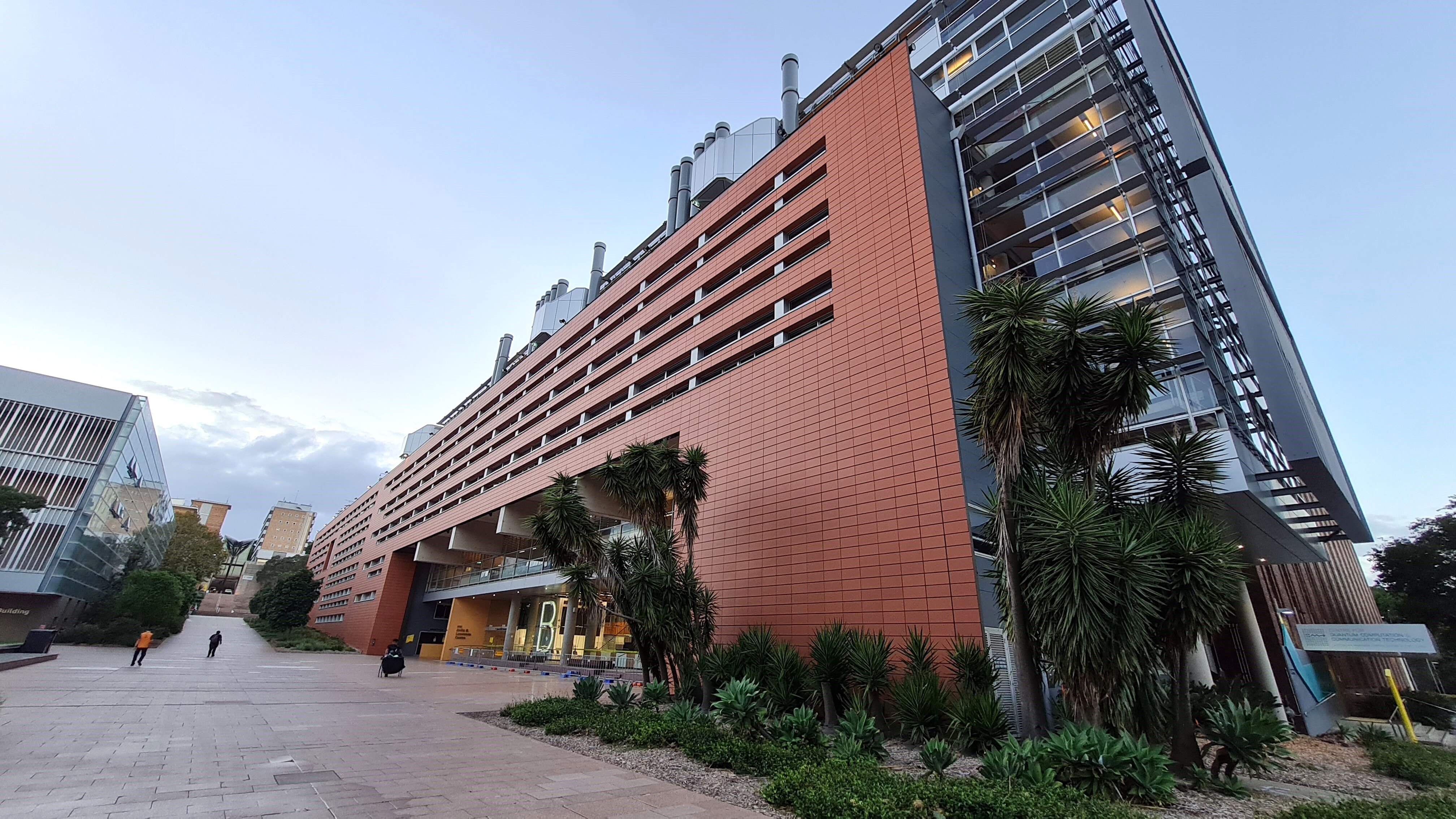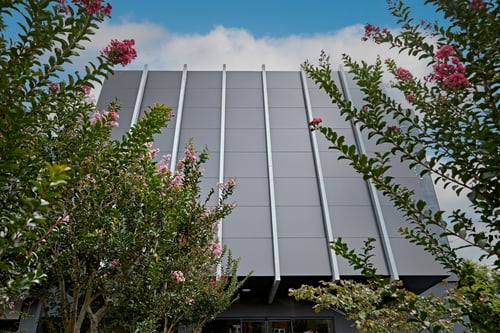Why going green will be key to securing your next government tender.
Legislative changes, shifting consumer preferences, and growing expectations for energy-efficient buildings have driven the Australian public sector to adopt and champion greener construction practices. As new standards are set, the ability to meet them becomes a primary factor in a) securing the project and b) achieving compliance and obtaining the necessary permits. Natural facade solutions have been the face of this change.
But looking good remains as important as going green. As cities evolve rapidly and environmental concerns amplify, the challenge of creating functional facades that prioritise environmental impact without sacrificing aesthetic appeal has never been more compelling.
Fairview has long been at the forefront of this evolution, pioneering high-performance natural cladding systems. Today, we offer various facade solutions that meet sustainability targets while maintaining a building's visual appeal.
This publication explores:
- The rise of sustainable facade systems, particularly in the health, education, and public infrastructure sectors and how Fairview has long championed this eco-friendly cladding evolution, pioneering high-performance natural cladding systems built to last.
- Fairview natural cladding products, in particular the new Genesis Signature range.
|
If your project needs a natural-look facade that’s friendlier to the environment, contact Fairview on 1800 007 175. |
The Government’s Growing Focus on Going Green
The Federal Government has firmly committed to making sustainable public infrastructure the standard, not the exception. To achieve this vision, it has implemented a raft of legislated and incentivised initiatives that reward best practices in construction and sustainability.
Government tenders for large or lucrative projects increasingly require bids prioritising environmental outcomes. Earlier this year, the Albanese Government announced the nation’s first Environmentally Sustainable Procurement Policy, which mandates that all government construction projects over $7.5M must meet a series of sustainability outcomes.
Net Zero Plan
The environment is a core focus for other major government policies, such as the Net Zero Plan, a blueprint for legislating net zero greenhouse gas emissions by 2050 (and a 2035 emissions reduction target).
Climate Active
The Federal Government’s Climate Active initiative encourages businesses to voluntarily adopt practices that lead to carbon neutrality. Achieving Climate Active certification — aligned with national and global greenhouse gas accounting protocols — gives projects a competitive edge, offering public recognition and a stronger market position.
We can see how government policy and initiatives affect change - let’s explore how some sectors demonstrate this change in action.
Sustainable Health Infrastructure
Providing medical care comes with a significant environmental cost, as hospitals are among the most energy-intensive buildings in the country. Tackling these challenges not only helps pave the way for a greener future; it also has ongoing benefits for the patients and staff who frequent these buildings. Indeed, the Green Building Council of Australia (GBCA) claims that green design can lead to shorter hospital stays, quicker recoveries, fewer secondary infections, and reduced reliance on pain medication.
Energy-efficient windows, solar panels, green spaces, rainwater harvesting, charging stations, sustainable transport infrastructure, and the use of recycled and natural materials are all part of the evolving landscape of greener hospitals.
A Sustainable Cladding System With Clyde Health Hub’s Smartbric Facade

Facade cladding can significantly affect the energy efficiency and sustainability of healthcare buildings. Monash Hospital’s Clyde Health Hub opted for Fairview's Smartbric. With its lightweight brick facade system, the building exhibits a sleek and minimalist design, combining aesthetic appeal with a commitment to sustainability.
Sustainable Education Infrastructure
It is perhaps no surprise that the sector shaping tomorrow’s decision-makers is itself a major innovator of green initiatives. Some of the finest examples of going green can be found in our schools, and it’s encouraging to think about the legacy this could leave on the next generation. Indeed, Winston Churchill once said, “We shape our buildings; thereafter they shape us”.
A GBCA Green Schools Report attributes green schools with a reduction in teacher turnover, sick leave, and absenteeism, as well as improved student learning and productivity, test scores, and health. The report goes on to say that green schools typically use one-third less energy and 32% less water than traditional build equivalents.
Hallmarks for an environmentally friendly school building include:
- Smart lighting system
- Solar panels
- Non-toxic materials in new builds or renovations
- Improved insulation
- More efficient temperature regulation and ventilated buildings
- Rainwater collection
- Increased greenery indoors and out
- Organic food in cafes
- Composting food waste
- Better facility management
Eco-Friendly Cladding Facades at UNSW and Picton High School
 It’s pleasing to see examples of outstanding sustainable facade design in primary, secondary and tertiary school buildings around the nation. For instance, the UNSW Kensington rectification project, which specified a combination of Fairview cladding systems across its exterior. The facade is comprised of 1,700m2 of Salmon Pastel terracotta facade panels. The natural materials, which would age beautifully with time, offset the more contemporary and sleek exterior, creating a striking and memorable juxtaposition.
It’s pleasing to see examples of outstanding sustainable facade design in primary, secondary and tertiary school buildings around the nation. For instance, the UNSW Kensington rectification project, which specified a combination of Fairview cladding systems across its exterior. The facade is comprised of 1,700m2 of Salmon Pastel terracotta facade panels. The natural materials, which would age beautifully with time, offset the more contemporary and sleek exterior, creating a striking and memorable juxtaposition.

Fairview also supplied a natural cladding panel system for Picton High School in NSW. This time, instead of turning to the softly-ageing qualities of terracotta, the team selected the modern, textured minimalism of Genesis compressed fibre cement, achieving a stylish, durable and environmentally friendly aesthetic.
Sustainable Public Infrastructure
Public infrastructure projects increasingly emphasise material sustainability before any development begins. Natural and organic products produced with minimal carbon footprint, recycled or reclaimed products that avoid contributing to landfill and locally-sourced products requiring little transport are all examples of coveted sustainable cladding materials.
Sensitive design principles are crucial in Australia’s efforts to combat climate change. Energy efficiency, reduced water consumption, weatherproofing, biophilia, and landscaping all have a vital role to play in protecting our public infrastructure and the people who engage with them.
Auchenflower Station Sustainable Cladding Facade

Sustainability doesn’t have to compromise aesthetics, as we see in the multi-million dollar upgrade of Queensland’s Auchenflower Station. Fairview supplied Genesis Raw in graphite and light slate to create a contemporary, long-lasting facade design.
High-Performing Sustainable Cladding Options From Fairview
With longer lifespan, reduced emissions, improved thermal and energy efficiency, and recyclability, natural facade materials provide significant advantages. Fairview is no stranger to the advantages of sustainable cladding systems and our natural cladding range continues to accommodate the rising demand for eco-friendly building solutions.
New Product - Genesis Signature Fibre Cement Cladding Panels

Fairview's new Genesis Signature range enriches design possibilities for designers and architects while still benefiting from the high performance and sustainable qualities that sustainable cladding systems offer.
Genesis Signature fibre cement panels come with a 50+ year design life and an extended 20-year warranty. The cladding is made from materials that reduce environmental impact and exude a bold, elegant and timeless appeal. A master class in design, Genesis is ideal for major projects such as hospitals, schools and health centres.
Genesis Awarded Environmental Product Declaration
Genesis cladding is one of three Fairview products to be awarded Environmental Product Declarations, an independently verified and registered document outlining details of the product’s entire environmental impact. Architects can save time researching - the EPD has done all the heavy-lifting - and be reassured of the product’s sustainability and reduced environmental impact not just in production but across its full lifecycle.
Smartbric Brick Facade

A ventilated rainscreen facade system with a 10-year warranty, Smartbric brick cladding uses an innovative universal mounting track or rail system for installation. Smartbric Rapid allows for a fast and mortarless application. This range is very well suited to heritage-style designs, restorations and even interior applications.
Clayton Terracotta Facade System

High-strength natural clay cladding panels deliver texture, warmth and tactility to projects. With a 15-year warranty, the Clayton terracotta facade system is long-lasting, offers high thermal insulation, reduces noise and has impressive UV and weather resistance qualities. These affordable panels are an excellent choice for a wide range of commercial and public projects, including schools, office buildings, hospitals, retail spaces, community centers, libraries, and government facilities.
Contact Us About Natural Cladding for Your Project
Sustainable facade systems are not a fad. They’re here to stay, and the expectation of specifying them will only increase. From public perception to government policy, the writing is on the wall. Fairview cladding products not only comply with increasingly stringent government standards, but we also set the bar in aesthetically pleasing facade solutions.
For cladding and facade solutions that are both durable and environmentally conscious while maintaining aesthetic beauty, choose Fairview.



